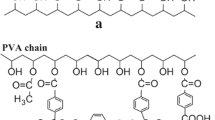Abstract
Induction and stabilization of liquid crystallinity through hydrogen bonding (HB) are now well-established. Interesting observations made on the influence of HB on LC behaviour of amido diol-based poly(esteramide)s, poly(esteramide)s containing nitro groups and azobenzene mesogen-based polyacrylates will be discussed. The use of amido diol as an important precursor for the synthesis of novel PEAs containing inbuilt di-amide linkage enabled generation of extensive hydrogen bondings between the amide-amide and amide-ester groups which stabilized the mesophase structures of the PEAs. The contributions of hydrogen bonding to the generation and stabilization of mesophase structures were plainly evident from the observation of liquid crystallinity even in PEAs prepared from fully aliphatic amido diols. Replacement of terephthaloyl units by isophthaloyl moiety totally vanquished liquid crystalline phases while biphenylene and naphthalene units did only reduce the transition temperatures as expected. The occurrence of the smectic phases in some of the polymers indicated possibly self-assembly through the formation of hetero intermolecular hydrogen bonded networks. A smectic polymorphism and in addition, a smectic-to-nematic transition, were observed in the monomers and polymers based on 1,4-phenylene[bis-(3-nitroanthranilidic acid)] containing nitro groups. A smectic polymorphism was also observed as a combined effect of hydrogen bonded carboxyl groups and laterally substituted alkyl side chains in the case of azobenzene mesogen containing side chain polyacrylates. It was further shown that the presence of the mesophase enhances the non-linear optical (NLO) response of these polymers.
Similar content being viewed by others
References
T Kato,Handbook of liquid crystals edited by D Demus, G Goodby, W Gray, H W Spiess and V W Vill (Wiley-VCH, 1998)
C M Paleos and D Tsiourvas,Liq. Cryst. 28, 1127 (2001)
S M Aharoni,Macromolecules 22, 686 (1989)
Fu-Sen Yen, Leih-Li Lin and Jin-Long Hong,Macromolecules 32, 3068(PEU) (1999)
J D Sudha and C K S Pillai,J. Polym. Sci. Polym. Chem. 38, 2469 (2000)
J D Sudha, C K S Pillai and S Bera,J. Polym. Mater. 13, 317 (1996)
J D Sudha, T R Ramamohan, C K S Pillai and K J Schariah,Euro. Polym. J. 35, 1637 (1999)
K Y Sandhya, C K S Pillai and K Sree Kumar,J. Polym. Sci. Polym. Phys. Ed. (2002) (in the Press)
M Saminathan, C K S Pillai and C Pavithran,Macromolecules 26, 7103 (1993)
M Saminathan and C K S Pillai,J. Polym. Mater. 18, 83 (2000)
M Saminathan and C K S Pillai,Macromol. Chem. Phys. 201, 2475 (2000)
K Y Sandhya, C K S Pillai, Masataka Sato and Naoto Tsutsumi,Macromol. Chem. Phys. 203, 1126 (2002)
Author information
Authors and Affiliations
Rights and permissions
About this article
Cite this article
Pillai, C.K.S., Sandhya, K.Y., Sudha, J.D. et al. Influence of hydrogen bonding on the generation and stabilization of liquid crystalline polyesters, poly(esteramide)s and polyacrylates. Pramana - J Phys 61, 417–423 (2003). https://doi.org/10.1007/BF02708321
Issue Date:
DOI: https://doi.org/10.1007/BF02708321




